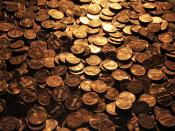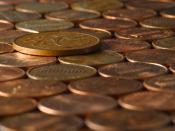Lab Report Purpose: The purpose of this lab experiment was to learn about the different densities of different kinds of metal. We used pennies made out of different metals to determine this. After we gather the data, it'll be used to determine the metal used.
Hypothesis: In the lab, I expect that the pennies before 1982 would be heavier than those that are after 1983 because the metal was initially changed because the earlier pennies cost more to make. So I think that since the heavier metal was more expensive to make, then they just used a cheaper metal. So if the metal was heavier it may have been more expensive to manufacture.
Procedure: 1. Choose either to use Pre-1982 or Post-1983 to start the experiment. Find the mass with the weight scale and then record it onto the data table.
2. Add 5 more pennies of the same kind then record the weight again.
3. Continue to repeat step 2 until you weighed all 25 pennies on the scale.
4. Fill the 50 mL graduated cylinder to 20 mL of water. Use the meniscus to measure the water level.
5. With the 25 pennies used before, drop 5 pennies into the water, and record the new water level.
6. Add 5 pennies again and record the new water level.
7. Repeat Step 6 8. Repeat Step 6 until all 25 the pennies are dropped into the graduated cylinder and all the volumes are recorded.
9. Dry the pennies and store them or give them to the teacher.
10. Do the same with the other set of pennies.
11. Find the net volume of both set of pennies. (Subtract 20 mL from the total volume).
12. Enter all data into specific columns.
Data and Observations: Data- 22mL-20mL = 2mL, 24mL-20mL = 4mL, 26mL-20mL = 6mL, 27.5mL- 20mL = 7.5mL, 29mL-20mL = 9mL Table 1- Pre-1982 22mL-20mL = 2mL, 23.5mL-20mL = 3.5mL, 25.5mL-20mL = 5.5mL, 27mL-20mL = 7mL, 29mL-20mL = 9ml Table 2- Post-1983 Observations- ÷ The scale wasn't able to accurately pick up how much the weight of the first 5 pennies were. The mass inputted was the weight it was roughly around the most.
÷ The next sets of pennies were also entered as the weight it mainly was throughout the time it was on the scale.
÷ While the pennies were dropped in the cylinder, splashes were made and some water either splashed out or made little drops on a higher lever in the graduated cylinder.
÷ On the 3 set of the post-1983 pennies, the pennies were placed crookedly into the cylinder and that caused the next two sets to be crooked. Group members decided that it wouldn't cause any differences in finding the volume of the pennies.
÷ The graph's points weren't in a straight line which mean that they were the right answer but, since the points were close they were acceptable.
÷ The group's solution for the slope and percent error of the pennies were wrong.
Analysis: While looking at the graph, I noticed that both types of pennies (in water) had almost the same weight. The lines of the graph were close together from the beginning which meant the volumes were probably close to one another. Also both lines never touched everything on the graph.
Although the graph seems similar, they also have many differences. The pre-1982 pennies were heavier illustrating that real copper is heavier than the metal used in pennies after 1983. The graph also projects that difference metals which seem similar to each other have different net volumes and masses.
Conclusion: Although two metals similar in weight were used to make pennies, there are difference in many ways. For example, the net volumes seem similar but the mass of the pennies were increased each time by a different amount.
My hypothesis was correct, although the metals weight were very close to one another. The metal for the pennies made before 1982 was determined as copper and the metal for the pennies made after 1983 was determined as zinc.
With this experiment, I found out different methods to find the volume of a solid just by using a measuring device and water. Using the right kind of mathematics can easily determine many different things in science. Like, for this experiment we used different types measurements to record known sets of data then we use that to find the unknowns of the equation. Then with all the blanks filled-in we could solve for the unknown. In this case it was finding what kinds of materials were used to make the two different types of pennies.


